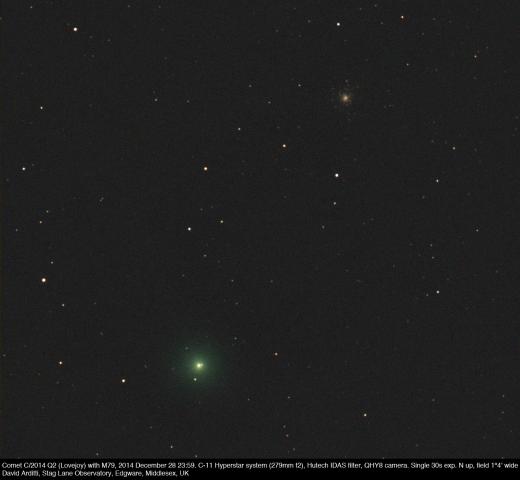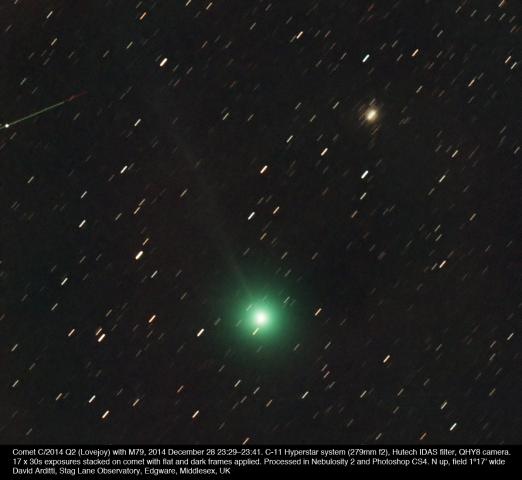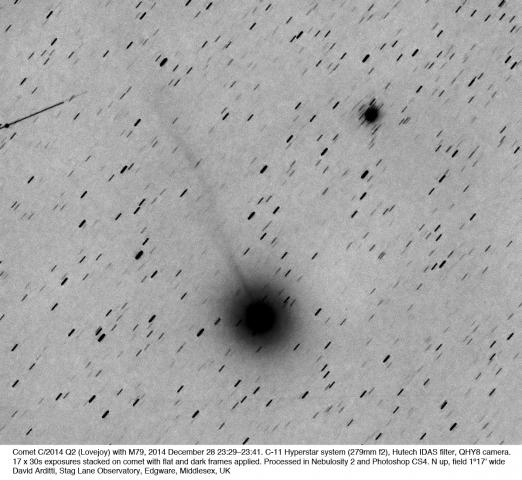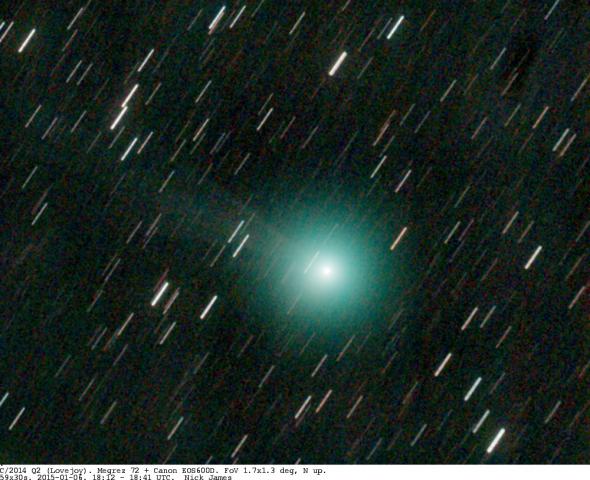- This topic has 10 replies, 6 voices, and was last updated 10 years, 11 months ago by
James Lancashire.
-
AuthorPosts
-
30 December 2014 at 8:04 pm #573403
 Nick JamesParticipant
Nick JamesParticipantI hope that all comet observers are getting a chance to observe this nice object. It is now observable from the UK and nice images are coming in although these are not yet matching the images from remote telescopes in Australia. The Moon will be a problem for the next couple of weeks so some of the best UK images will probably start appearing in mid January.
The BAA is updating the image archive daily and there are now almost 100 images available from all over the world. You should regularly have a look at the page:
http://www.britastro.org/cometobs/2014q2/
If you are a BAA member it is best to be logged in to the site since you will see updates earlier. This is because our pages are served to logged in members without having to wait for the normal cache updates.
I’ve been observing the comet using the iTelescope telescopes at Siding Spring, particularly the T12 instrument that has a 3.9×2.6 deg FoV. It’s interesting to compare the tail on Dec 19th and today in these two images:
http://www.britastro.org/cometobs/2014q2/2014q2_20141219_ndj.jpg
http://www.britastro.org/cometobs/2014q2/2014q2_20141230_1433_ndj.jpgI’ve also imaged the comet from the UK using a Megrez 72 and Canon 600D DSLR:
http://www.britastro.org/cometobs/2014q2/2014q2_20141228_2232_ndj.jpg
This image is nothing like the quality of the remote images but I feel much more “ownership” of it and expect to get a lot better later in January. I’ve also seen the comet in 10×50 bins despite the low altitude and light pollution. It was surprisingly easy and, if you haven’t looked yet, it is worth a try. Interestingly I also imaged the comet from here yesterday night and despite what appeared to be better conditions the ion tail appears much fainter.
As always, please submit your observations to cometobs@britastro.org. Denis Buczynski is doing a great job of updating the archive but please help us by using the correct filename format, i.e.:
2014q2_20141228_2232_ndj.jpg
where “20141228_2232” is the date and time and “ndj” is the observer name.
Very many thanks to Terry for finding yet another nice object.
Nick.
30 December 2014 at 11:35 pm #576727 David ArdittiParticipant
David ArdittiParticipantOne small point worth clarifying about the required file-naming format, because it isn’t stated anywhere, so I had to ask, is that the time in the file name should be the mid-time of the image. So if, as common, you stack a series of sub-exposures, you need to work out what the mid-time was for the sequence.
Maybe this was obvious to everone else, but not to me.
David
30 December 2014 at 11:54 pm #576728 David ArdittiParticipant
David ArdittiParticipantHere is the result I was able to get from a light-polluted London suburb the first night it attained enough altitude, Dec. 28/29. A single 30s exposure shows it with M79 to upper right.

A stack of 17 exposures, with extensive processing, revealed the tail (this surprised me considering the conditions and the 14 degree altitude).

Inverting this image and making it mono shows the tail better.

I could not see the comet visually with 10×50 binoculars, but I expect I soon will be able to. As it gains altitude certainly UK imagers will be able to reveal far more detail than this.
David
31 December 2014 at 8:31 am #576729 Nick JamesParticipant
Nick JamesParticipantDavid,
Thanks for your UK image. Sounds like you had to do some considerable gardening to get it!
While we would prefer the time part of the filename to be the mid-time of the exposure this is not essential and we’re happy with start, middle or end. Ideally the caption on the figure should state which one is used, particularly where the total exposure time is long. The time part is actually optional so 2014q2_20141230_ndj.jpg and 2014q2_20141230_1452_ndj.jpg are both valid. I use the time to distinguish between multiple images taken on the same day, or even sometimes multiple ways of processing the same image.
All the pages of the comet archive are automatically generated by scripts which depend on the correct filename structure. At present we are receiving 30-40 images of 2014 Q2 each day. This will no doubt increase so it does help us greatly if the filename conforms to these rules.
Nick.
6 January 2015 at 9:25 pm #576747 Nick JamesParticipant
Nick JamesParticipantMy first image of this comet from my garden in Chelmsford. Over Christmas I was away in Somerset and had seen it from down there. Tonight I rushed home from work to take advantage of the nice clear sky. I had a good view of the comet visually in 11x80bins as the Moon was rising in the east. It was quite a large fuzz-ball but with no sign of a tail. This comet is definitely worth a loook and should be fairly easy to find with a pair of bins using the chart here. The Moon is now moving out of the way and this comet will be at its best for us over the next couple of weeks.
 11 January 2015 at 12:59 pm #576764
11 January 2015 at 12:59 pm #576764 Jeremy ShearsParticipant
Jeremy ShearsParticipantI had my first naked eye view of the comet last night and it was seen well in 8 x 40 binos.
It’s not often we get to see a bright comet, so I hope others will have an opportunity to look at it.
Go well!
Jeremy
11 January 2015 at 4:07 pm #576765 Prof Paul T CurtisParticipant
Prof Paul T CurtisParticipantYes I got a good view of the comet last night too – it was a nice sight in binoculars. Here’s a link to an image I took last night.
Paul
11 January 2015 at 4:08 pm #57676615 January 2015 at 12:57 am #576775James Lancashire
ParticipantWith poor weather recently I’ve only managed a couple of views. Not naked eye from central Bristol and no sign of the tail with 12×32 binocs but certainly an impressive sight. I made it larger and slightly brighter and more condensed on Jan 13th compared with 10th. If next week goes cold and wintry then may still manage to make the most of the perihelion ‘plateau’.
15 January 2015 at 6:42 am #576776 Paul Anthony BrierleyParticipant
Paul Anthony BrierleyParticipantThis comet is proving elusive to me.
I have seen it twice through binoculars, but. Every time I try and take an image. The clouds return.
I have also been un-successful in making an observation without optical aid.
23 January 2015 at 1:59 am #576780James Lancashire
ParticipantAt midnight on Jan 22/23 I made Lovejoy slightly smaller, fainter and less condensed than a week ago, though it was at a lower elevation with low level fog and 12×32 B eyepieces dewing up. Fingers crossed for another clear evening for better comparision over weekend.
-
AuthorPosts
- You must be logged in to reply to this topic.
